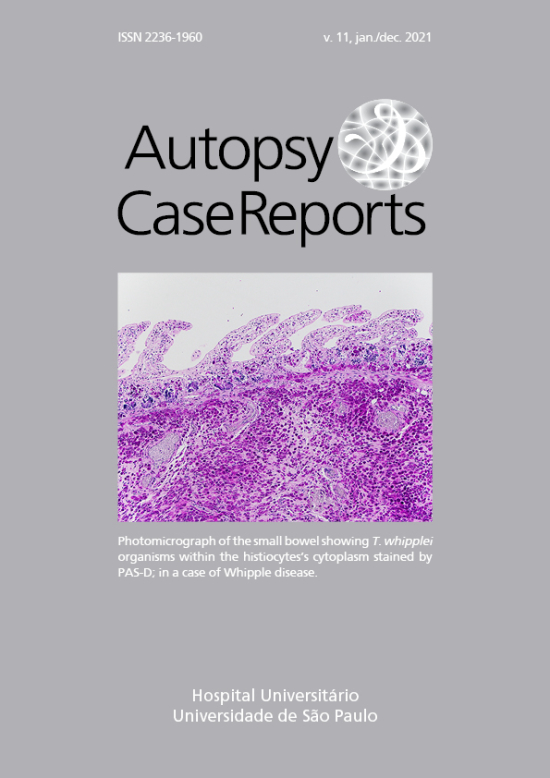Anatomic and radiological correlation of injectate spread from first thoracic costotransverse junction in cervical erector spinae plane
DOI:
https://doi.org/10.4322/acr.2021.275Keywords:
Anesthesia conduction, Ultrasonography, Nerve block, Dissection, CadaverAbstract
Introduction: Cervical erector spinae plane block (ESPB) provides postoperative pain relief when administered at the level of first thoracic costotransverse junction (CTJ) for surgeries on the proximal shoulder and cervical spine. We propose to describe the spread of 20 ml radiocontrast - dye solution administered at this level from caudad to cephalad direction in a fresh frozen cadaveric model through imaging and cross-sections. Methods: An observational study with four thoracic to cervical ESP blocks at the level of first thoracic CTJ level on two fresh cadavers (total 4 specimens) was conducted using 20 ml of radiocontrast- methylene blue combination (10 ml through the needle and 10 ml through the catheter). Both cadavers were subjected to computed tomography (CT) scan. An anatomist and radiologist, respectively, analyzed cross-sections of cadavers and CT contrasted images. Results: The spread was assessed in axial, sagittal, and coronal at the levels of C4, C5, C6, C7and T1. The medial limit was articular processes in both cadavers. The lateral limits were the outer border of the middle scalene muscle in cadaver 1 and posterior to the sternocleidomastoid muscle in cadaver 2. Contrast spread was visualized on the superior and anterior aspect of anterior scalene muscle in cadaver 2. An epidural spread was observed at the level of C5-6 and C6-7 in axial and coronal planes in cadaver 1. Conclusions: The cervical ESPB administered at the first thoracic CTJ with injections directed cephalad has a consistent action on the dorsal spinal nerves of thoracic and cervical area, and spreads in the paravertebral space dorsal to the ventral cervical roots.
Downloads
References
Henson B, Kadiyala B, Edens MA. Anatomy, back, muscles [Internet]. Treasure Island (FL): StatPearls Publishing; 2021 [cited 2021 Mar 6]. Available from: https://www.ncbi.nlm.nih.gov/books/NBK537074/
Forero M, Adhikary SD, Lopez H, Tsui C, Chin KJ. The erector spinae plane block: a novel analgesic technique in thoracic neuropathic pain. Reg Anesth Pain Med. 2016;41(5):621-7. http://dx.doi.org/10.1097/AAP.0000000000000451.
Veiga M, Costa D, Brazão I. Erector spinae plane block for radical mastectomy: a new indication? Rev Esp Anestesiol Reanim. 2018;65(2):112-5. http://dx.doi.org/10.1016/j.redar.2017.08.004. PMid:29102405.
Hamilton DL, Manickam B. Erector spinae plane block for pain relief in rib fractures. Br J Anaesth. 2017;118(3):474-5. http://dx.doi.org/10.1093/bja/aex013. PMid:28203765.
Chin KJ, Adhikary S, Sarwani N, Forero M. The analgesic efficacy of pre-operative bilateral erector spinae plane (ESP) blocks in patients having ventral hernia repair. Anaesthesia. 2017;72(4):452-60. http://dx.doi.org/10.1111/anae.13814. PMid:28188621.
Melvin JP, Schrot RJ, Chu GM, Chin KJ. Low thoracic erector spinae plane block for perioperative analgesia in lumbosacral spine surgery: a case series. Can J Anaesth. 2018;65(9):1057-65. http://dx.doi.org/10.1007/s12630-018-1145-8. PMid:29704223.
Hamadnalla H, Elsharkawy H, Shimada T, Maheshwari K, Esa WAS, Tsui BCH. Cervical erector spinae plane block catheter for shoulder disarticulation surgery. Can J Anaesth. 2019;66(9):1129-31. http://dx.doi.org/10.1007/s12630-019-01421-9. PMid:31161549.
Ma W, Sun L, Ngai L, et al. Motor-sparing high-thoracic erector spinae plane block for proximal humerus surgery and total shoulder arthroplasty surgery: clinical evidence for differential peripheral nerve block? Can J Anaesth. 2019;66(10):1274-5. http://dx.doi.org/10.1007/s12630-019-01442-4. PMid:31290120.
Diwan S, Nair A. Erector spinae plane block for proximal shoulder surgery: a phrenic nerve sparing block! Turk J Anaesthesiol Reanim. 2020;48(4):331-3. http://dx.doi.org/10.5152/TJAR.2019.55047. PMid:32864650.
Zhang J, Tsuzuki N, Hirabayashi S, Saiki K, Fujita K. Surgical anatomy of the nerves and muscles in the posterior cervical spine: a guide for avoiding inadvertent nerve injuries during the posterior approach. Spine. 2003;28(13):1379-84. http://dx.doi.org/10.1097/01.BRS.0000067095.75764.D3. PMid:12838094.
Elsharkawy H, Ince I, Hamadnalla H, Drake RL, Tsui BCH. Cervical erector spinae plane block: a cadaver study. Reg Anesth Pain Med. 2020;45(7):552-6. http://dx.doi.org/10.1136/rapm-2019-101154. PMid:32321860.
Downloads
Published
Issue
Section
License
Copyright (c) 2021 Autopsy and Case Reports

This work is licensed under a Creative Commons Attribution 4.0 International License.
Copyright
Authors of articles published by Autopsy and Case Report retain the copyright of their work without restrictions, licensing it under the Creative Commons Attribution License - CC-BY, which allows articles to be re-used and re-distributed without restriction, as long as the original work is correctly cited.



